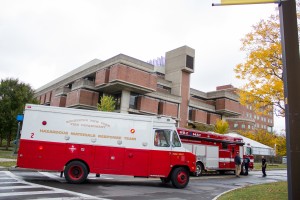Emergency crews and local Hazmat units responded to a call from Hutchison Hall on Saturday at approximately 2:40pm in response to an accident in a lab where three graduate students of UR’s Chemistry Department were working. Following the explosion, the building was evacuated. The preparation for several Meliora Weekend events was delayed and a few events were relocated to other buildings until Hutchison was cleared by emergency response teams.
The graduate students, Jared Kneebone, Kathlyn Fillman, and Malik Al-Afyouni, are members of Assistant Professor of Chemistry Michael Neidig’s research group. According to Neidig, at the time of the incident, only one of the three students was performing work directly related to the accident.
In a statement to the Campus Times written by Kneebone on behalf of the other students, an “aqueous nitric acid solution was being disposed of as a waste into a properly designated acidic aqueous waste container.” In the seconds following its disposal, a hissing was heard from the container, followed by its explosion. According to Neidig, the explosion was a result of pressure buildup, and there was no fire involved.
Following the explosion, the students used the emergency wash stations in the lab and then called 911, per laboratory protocol. They sustained minor injuries from flying shards of glass, and were released from Strong Memorial Hospital Saturday evening.
“As individuals who were exposed to the explosion, we feel very fortunate that we were not hurt more seriously,” Kneebone wrote in the statement.
“We continue to recover physically and look forward to getting back to our chemistry.”
According to a Kneebone’s statement, the container held no other acidic waste prior to the disposal of the aqueous nitric acid. He went on to identify a likely explanation for the accident: according to laboratory protocol, the bottle would have been rinsed with organic compounds prior to being used as a container for liquid chemical waste disposal. However, if any trace amounts of solvents used to rinse the bottle, such as acetone or ethanol, remained, that would account for the “explosive gas-evolution process” that occurred when the nitric acid solution was added to the container.
Neidig outlined the departmental response following the incident.
“When anything like this happens, the department will meet with everyone involved and the faculty as a whole in order to learn from the experience and modify our safety protocols accordingly to reduce the chances of a similar incident in the future,” he wrote in an email. “The department is taking direct steps to ensure this kind of over-pressure incident with acidic waste does not occur again.”
The first meeting took place on Tuesday. Among the action steps was a mandate on the use of “pressure relief funnel caps […] on all acidic waste bottles,” and the investigation of alternative non-glass storage options for waste.
Kneebone said the incident also demonstrates the reality of laboratory research.
“This incident illustrates an ever-present possibility in a chemical laboratory, one which must be acknowledged by all chemists: that even after following normal safety protocols when working with and disposing of chemicals, things can still go wrong,” Kneebone wrote. “Within our lab and across the chemistry department, discussions are ongoing about what we can all do to not only avoid incidents like these in the future, but also to define the proper steps to take to help contain incidents like this should something happen that is beyond our control.”
Remus is a member of
the class of 2016.






